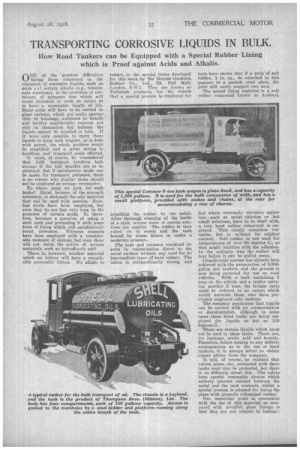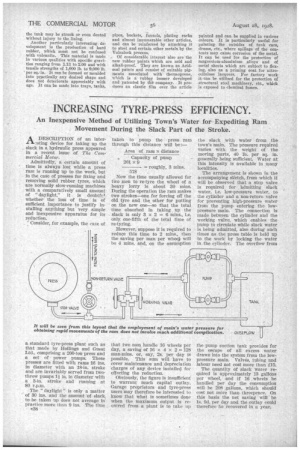TRANSPORTING CORROSIVE LIQUIDS IN BULK.
Page 21

Page 22

If you've noticed an error in this article please click here to report it so we can fix it.
How Road Tankers can be Equipped with a Special Rubber Lining which is Proof against Acids and Alkalis.
ONE of the greatest difficulties facing those concerned in the transport of corrosive liquids, such as acids a e.1 certain alkalis (e.g., causticsoda solutions), is the provision of containers of adequate size which will resist corrosion to such aia extent as to have a reasonable length of life. Many acids still have to be carried in glass carboys, which are easily susceptible to breakage, awkward to •handk and involve considerable expense not only in themselves but beeause the liquids cannot be handled in bulk. If it were only possible to carry these liquids in large tank wagons, as is done with petrol, the whole problem would be simplified and a great saving in handling and transport costs effected.
It must, of course, be remembered that bulk transport involves bulk storage if the full benefits are to be obtained, but if satisfactory tanks can be made for transport purposes, there is no reason why similar tanks should not be employed as storage receptacles To where must we look for such tanks? Metal, because of the strength necessary, is obviously the only material that can be used with success. Rustless steels have been employed, but even they do not last very long in the presence of certain acids. It, therefore, becomes a question of using a steel tank and protecting it with some form of lining Which will satisfactorily resist corrosion. Vitreous enamels have been employed with a considerable measure of success, but even these will not resist the action of certain materials, such as hydrofluoric acid.
There is, however, another material which we believe will have a remarkably successful future. We allude to rubber, in the special forms developed for this work by the British Goodrich Rubber Co., Ltd., 50, Pall Mall, London, S.W.I. They are known as VuIcalock products, for the reason that a special process is employed for attaching the rubber to the metal. After thorough cleaning of the inside of a Lank, several coats of special solutions are applied. The rubber is then rolled on in sheets and the tank heated by steam blown in under a moderate pressure.
The heat and pressure combined results in vulcanization direct to the metal surface without any need for an intermediate layer of hard rubber. The union is extraordinarily strong, and tests have shown that if a strip of soft rubber, 1 in. sq., be attached in this manner to a smooth steel plate, the joint will easily support two men.
The actual lining material is a soft rubber compound known as Acidseal, but where extremely corrosive materials, -such as moist chlorine or hot alkali solutions, have to be dealt with, a very hard rubber compound is employed. This closely resembles vulcanite, but is without its sulphur content. Soft rubber is not used for temperatures of over 60 degrees C., as they might interfere with the adhesion. In the ordinary way the rubber will tear before it can be pulled away.
Considerable success has already been achieved with the preparation of 8,000gallon rail tankers, and the process is now being extended for use on road vehicles. With a tank containing 5 tons on the vehicle and a trailer carrying another 5 tons, the freight rates could be reduced to an extent which would astonish those who have previously employed only carboys.
The company guarantees that liquids can be carried with no contamination or discolouration, although in some cases these lined tanks are being employed for liquids as hot as 110 degrees C.
There are certain liquids which must not be used in these tanks. There are, for instance, acetic acid and benzoic. Therefore, before coming to any definite arrangements as to the use of lined tankers, it is always better to obtain expert advice from the company.
It will, of course, be realized that valves, pipes, etc., connected with these tanks must also be protected, but there is no difficulty about this. The valves have special renewable sleeves which entirely prevent contact between the metal and the tank contents, whilst a special process is adopted for lining the pipes with properly vulcanized rubber.
One important point in connection with the use of this material as compared with so-called glass linings is that they are not subject to leakage: the tank may be struck or even dented without injury to the lining.
Another particularly interesting development is the production of hard rubber, whicli must not be confused with vulcanite. This material is made in various qualities with specific gravities ranging from 1.13 to 2.00 and with tensile strengths of 1,000 lb. to 9,000 lb. ' per sq. in. It can be farmed or moulded into practically any desired shape and does not deteriorate appreciably with age. It can be made into trays, tanks,
pipes, buckets, funnels, plating racks and almost innumerable other articles, and can be reinforced by attaching it to steel and certain other metals by the "Vulcalock process.
Of considerable interest also are the new rubber paints which arc acid and alkali-proof. They are known as Addseal paints and consist of suitable pigments associated with thermoprene, which is a rubber isomer developed and patented by the company. It produces an elastic film over the article painted and can be supplied in various colours. It is particularly useful for painting the outsides of tank cars, drums, etc., where spillage of the contents may cause corrosion of the metal. It can be used for the protection of magnesium-aluminium alloys and of metal sheets which are subject to flexing, also as a priming coat for nitrocellulose lacquers. For factory work' it, can be utilized for the protection of structural steel machinery, etc., which is exposed to chemical fumes.
































